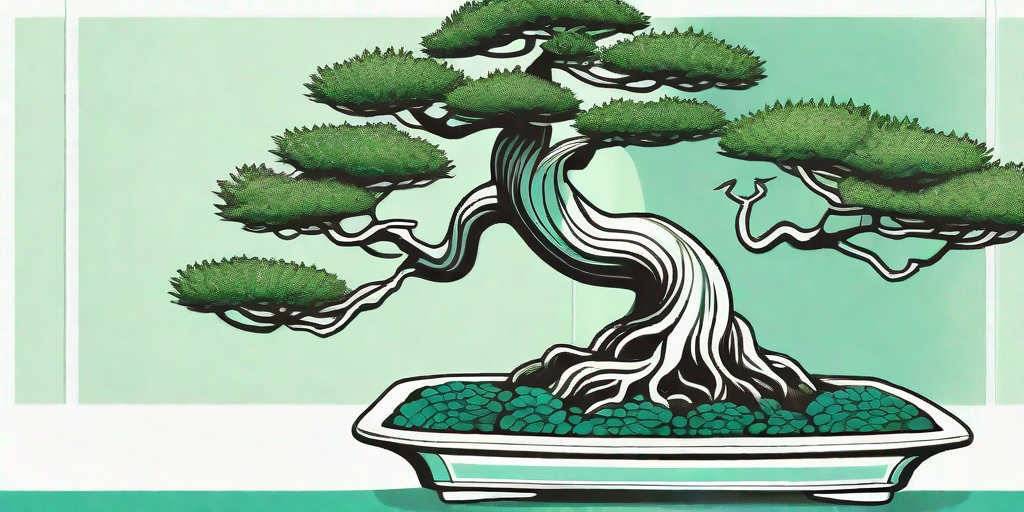
Welcome, fellow green thumbs and bonsai enthusiasts! Today, we're going to delve into the magical world of the cascading Juniper bonsai, a miniature masterpiece that can bring a touch of Zen to any space. Whether you're a seasoned bonsai veteran or a curious newbie, this guide will help you navigate the twists and turns of growing and caring for this unique plant.
The Juniper Bonsai: A Tiny Titan
The Juniper bonsai is a small but mighty specimen, known for its resilience and versatility. Originating from Japan, this little tree has taken the world by storm, winning hearts with its delicate foliage and dramatic cascading form. But don't let its dainty appearance fool you - this is one tough cookie that can withstand a variety of conditions.
Junipers are coniferous plants, meaning they bear cones and have needle-like leaves. They're also evergreen, so you can enjoy their lush greenery all year round. But the real showstopper is the cascading Juniper bonsai, a style known as "Kengai" in Japanese. This style mimics the look of trees growing on steep cliffs, their branches reaching downwards as if defying gravity itself.
Planting Your Juniper Bonsai
Now that you're acquainted with this miniature marvel, let's get down to the nitty-gritty - planting your Juniper bonsai. This is where your journey begins, and it's a journey filled with patience, care, and a dash of creativity.
First things first, you'll need a suitable pot. Bonsai pots are shallow and wide, allowing the roots to spread out and the tree to maintain its balance. Remember, your Juniper bonsai will be leaning over the edge of the pot in a cascading fashion, so stability is key.
Next, you'll need a good-quality bonsai soil mix. This should be well-draining to prevent waterlogging, but also capable of retaining enough moisture to keep your bonsai hydrated. A mix of akadama, pumice, and lava rock is a popular choice among bonsai enthusiasts.
Once you've got your pot and soil sorted, it's time to plant your Juniper bonsai. Place the tree in the pot, spreading out the roots gently. Then, cover the roots with soil, pressing down lightly to ensure the tree is secure. And voila! You've planted your Juniper bonsai.
Caring for Your Juniper Bonsai
Now that your bonsai is comfortably nestled in its new home, it's time to learn how to care for it. This involves watering, feeding, pruning, and protecting it from pests and diseases.
Watering Your Bonsai
When it comes to watering your Juniper bonsai, it's all about balance. Too much water can lead to root rot, while too little can leave your bonsai parched. The key is to keep the soil slightly moist at all times. This usually means watering your bonsai every two to three days, but this can vary depending on the climate and the size of your pot.
A good rule of thumb is to water your bonsai when the top inch of soil feels dry to the touch. And remember, it's better to water thoroughly less frequently than to give your bonsai little sips of water every day.
Feeding Your Bonsai
Your Juniper bonsai is a hungry little tree, and it needs regular feeding to stay healthy and vibrant. A balanced bonsai fertilizer, applied every two weeks during the growing season, should do the trick. Just be sure to follow the instructions on the packaging to avoid overfeeding.
And don't forget to give your bonsai a break from feeding during the winter months. This is its dormant period, and it needs less nutrients during this time.
Pruning Your Bonsai
Pruning is an essential part of bonsai care, and it's where you can really let your creativity shine. By carefully trimming the branches and leaves, you can shape your Juniper bonsai into a cascading work of art.
But remember, pruning is not just about aesthetics. It also helps to maintain the health of your bonsai by encouraging new growth and preventing overcrowding.
Protecting Your Bonsai
Even with the best care, your Juniper bonsai can still fall prey to pests and diseases. Common culprits include aphids, spider mites, and fungal infections. Regular inspections can help you spot any problems early, and treatments such as insecticidal soap or fungicide can nip these issues in the bud.
And remember, a healthy bonsai is a happy bonsai. So keep up with your watering, feeding, and pruning routine, and your Juniper bonsai will be more likely to fend off any pesky invaders.
FAQs About Juniper Bonsai
- Can I grow a Juniper bonsai from seed?
Yes, you can! However, growing a bonsai from seed is a long and challenging process. It can take several years for a seedling to mature into a bonsai-worthy tree. If you're new to bonsai, you might find it easier to start with a young tree or a bonsai starter kit.
- Can I keep my Juniper bonsai indoors?
While it's possible to keep a Juniper bonsai indoors, it's not ideal. Junipers are outdoor trees, and they need plenty of sunlight and fresh air to thrive. If you must keep your bonsai indoors, place it near a sunny window and consider using a grow light to supplement natural light.
- How often should I repot my Juniper bonsai?
Young Juniper bonsai should be repotted every two years, while older trees can be repotted every three to five years. Repotting helps to refresh the soil and prevent the roots from becoming pot-bound.
Conclusion
And there you have it, folks! A comprehensive guide to unleashing the beauty of your cascading Juniper bonsai. With a bit of patience, a dash of creativity, and a whole lot of love, you can grow and care for your very own miniature masterpiece. So roll up your sleeves, get your hands dirty, and embark on the rewarding journey of bonsai care. Happy growing!















